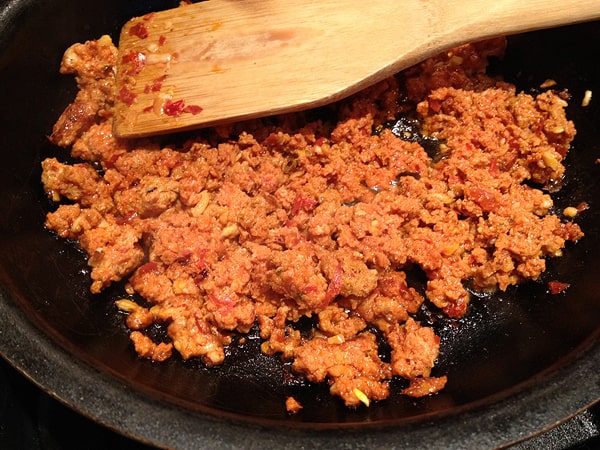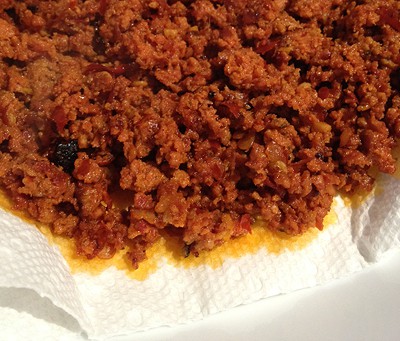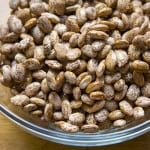Homemade chorizo is a lot easier to make than you think!
I always used to buy chorizo prepackaged or from the butcher because I thought it would be too hard to make at home. After months of wondering, I finally decided to delve in and give it a shot. The results were fantastic! Now that I know how incredibly easy it is to do on my own, I’ll think twice next time I reach for a package of chorizo in the grocery store.
RELATED RECIPE: Queso fundido with chorizo
A lot of people think of Spanish chorizo when they read chorizo in an ingredient list, and though Mexican chorizo is different, it’s equally delicious. Spanish chorizo is a hard, cured meat (think similar to a cured hard salami), and Mexican chorizo is a soft sausage-like meat, almost like a breakfast sausage patty if you broke it up into little bite-size pieces.
I love to use chorizo in a variety of ways: anything from breakfast dishes such as huevo con chorizo, to snacks such as queso fundido, to spicing up vegetables in dishes such as calabacitas rellenas. It’s also great as a topper to tostadas or sopes, and can be used to make fun little party appetizers like these chorizo and avocado cups with chipotle crema.
RELATED RECIPE: Huevo con chorizo breakfast tacos
I used a blend of three chiles to make my homemade chorizo slightly spicy and also some chopped onion and garlic to give it the right texture. The vinegar helps with giving the meat the signature crumble of Mexican chorizo.
This chorizo needs to be cured in the refrigerator for 4-6 days to allow the chiles and garlic to mellow, and for the vinegar to do its work on the texture.
My chorizo recipe was recommended by the New York Times Diner's Journal in December 2011.
Ingredients
- 1 pound ground pork
- 2 cups of water (for soaking the chiles)
- 4 chile guajillo
- 3 chile de arbol
- 1 chile ancho
- 1/2 teaspoon Mexican oregano
- 1/4 teaspoon black pepper
- 1 1/2 teaspoon kosher salt
- 2 quarter-inch thick slice of white onion (one slice will go in food processor; other will be finely chopped)
- 7 large garlic cloves (reserve 2 for later)
- 1 tablespoon apple cider vinegar
- 2 tablespoons Nakano rice vinegar
Instructions
- Bring two cups of water to a boil and remove from heat. Tear off the chile stems and soak the chiles for at least an hour or until completely soft. When the chiles are soft, remove them from the water, drain, and discard all the water. Do not remove the seeds from the chiles.
- Place the chiles, oregano, salt, pepper, one quarter-inch thick slice of onion and five cloves of garlic into the food processor or blender. Run for 5-10 seconds. Add the apple cider vinegar and rice vinegar. Reseal top of food processor or blender and pulse until the mixture is a smooth paste.
- In a glass mixing bowl, add the ground pork and make a well in the middle of the meat. Add half of the chile mixture and gently work it into the meat. Add the second half and repeat.
- In the food processor add the two remaining garlic cloves and pulse a few times so that it's roughly chopped. Add to the meat and chile mixture.
- Finely chop the second quarter-inch thick slice of onion. Add to meat and mix well to incorporate.
- Transfer the chorizo to an airtight container or a plastic zippered bag and store in the refrigerator for four to six days. It needs that time to cure and for the seasoning to mellow out. If you eat it before curing it, it may taste too spicy or too salty, the garlic will be very potent and the vinegar will be strong. If you can bear to leave it alone for six days to cure, it's worth the wait.
- After a few days, some liquid will run off the meat, which is completely normal. You can dump it out when you notice it or you can leave it up until you're ready to cook the chorizo. Be sure to discard the liquid either way.
- When it's ready to be eaten, just heat a frying man over medium heat, add the chorizo and fry it up until it's crumbly and well-done. Drain over paper towels and use in your favorite dish.
Notes
You can refrigerate cooked or uncooked leftovers for a few days or freeze raw meat in an airtight container or plastic zippered bag for a few weeks.
RELATED RECIPE: Trenza de huevo con chorizo



